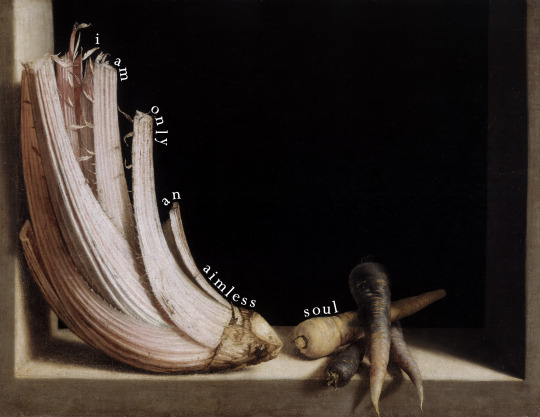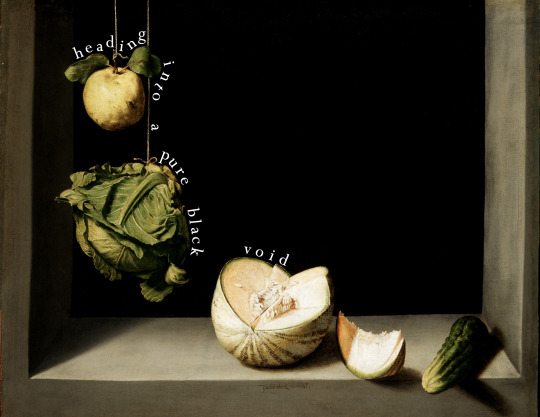#juan sánchez cotán
Explore tagged Tumblr posts
Text

Juan Sánchez Cotán (Spanish, 1560-1627) Inmaculate Conception, ca.1617-18 Museo de Bellas Artes de Granada
#Juan Sánchez Cotán#Juan Sanchez Cotan#Spanish art#Spanish#Spain#art#fine art#european art#europe#classical art#european#fine arts#oil painting#europa#mediterranean#Inmaculate Conception#1600s
150 notes
·
View notes
Text

Juan Sánchez Cotán (1560–1627) • Still Life with Fruits and Vegetables • c. 1600
#still life#art#painting#fine art#art history#oil painting#fruit/vegetable still life#juan sánchez cotán#spanish artist#painter#artwork#17th century european art#baroque still life#art of the still life blog#art blogs on tumblr#art lovers on tumblr#art appreciation
44 notes
·
View notes
Text


Cardoon and Carrots – Juan Sánchez Cotán // Quince, Cabbage, Melon, and Cucumber – Juan Sánchez Cotán // Vide Noir – Lord Huron
#juan sánchez cotán#still life#still life painting#still life art#vide noir#vide noir song#vide noir album#lord huron#art#art history#lyrics#lyric art
39 notes
·
View notes
Text
Amazingly enough, Magdalena Ventura is not the only painting of The Bearded Woman from the Baroque period. Ribera's compatriot Juan Sánchez Cotán (most famous for his still-lifes), also tried his hand at this unlikely subject. La Barbuda de Peñarando is the portrait of The Bearded Brígada del Río who allegedly visited the court in Madrid in the 1590s. Seventeenth century prints of bearded ladies also abounded in England. This sudden, unusual interest in hirsutism (a serious hormonal disorder which causes excessive hair growth in women, amongst other problems) was nothing out of the ordinary for the Baroque. This artists and collectors of the period seem to have been virtually obsessed with the freakish, grotesque and bizarre: paintings of dwarves, buffoons, gluttons, and general immoral behavior and debauchery abound. This love for the strange was apparently of a particularly dark strain in the Spanish artists: Ribera's paintings in particular were filled with abnormal personages, dark themes and sinister activities.
Artble: The Bearded Woman/The Bearded Woman Related Paintings
#quotes#art history#The Bearded Woman#hypertrichosis#freak shows#Jusepe de Ribera#Magdalena Ventura#Juan Sánchez Cotán#La Barbuda de Peñarando#Brigida del Rio#Baroque art#16th century#1500s#Spanish art
1 note
·
View note
Text

BODEGÓN JUAN SÁNCHEZ COTÁN (1561-1627) MUEO DEL PRADO MADRID
0 notes
Text

Juan Sánchez Cotán
Bodegón con cardo y zanahorias (bodegón del cardo), (c.1603-1627)
0 notes
Photo
stilllifequickheart:
Juan Sánchez Cotán
Still Life with Quince, Cabbage, Melon and Cucumber
1600

25 notes
·
View notes
Text

MWW Artwork of the Day (11/29/24) Claudio Bravo (Chilean, 1936-2011) Still Life (1982) Oil on canvas, 81 x 100 cm. Private Collection
Bravo's ability to depict complex objects and shapes is reminiscent of Velázquez. His interest in Renaissance and Baroque works came from his many visits to the Museo del Prado in Madrid where he admired paintings done by old Spanish and Italian masters. Specifically he was inspired by Diego Velázquez for his light effects, Francisco de Zurbarán’s cloth studies, Juan Sánchez Cotán’s still lifes, Juan van der Hamen who popularized still life painting in Madrid, and Luis Egidio Meléndez who had great technical skill in using light to depict texture.
4 notes
·
View notes
Text

Still life with quince, cabbage, melon, and cucumber - c. 1602, Juan Sánchez Cotán
#beautiful vegetables#beautiful vegetable art#vegetables#food#quince#cabbage#melon#cucumber#painting#17th century#still life
12 notes
·
View notes
Text

Juan Sánchez Cotán, Still Life with Quince, Cabbage, Melon and Cucumber, ca. 1602, oil/canvas (Museum of Art, San Diego)
42 notes
·
View notes
Text

Juan Sánchez Cotán (Spanish, 1560-1627) Saint John Baptist, Detail, ca.1603-05 Museo de Bellas Artes de Granada Agnus Dei, qui tolis peccata mundi, miserere nobis. Agnus Dei, qui tolis peccata mundi, dona nobis pacem.
#Juan Sánchez Cotán#spanish art#spanish#spain#saint john baptist#1600s#art#fine art#european art#classical art#europe#european#fine arts#oil painting#europa#mediterranean#christian art#christian#christianity#christentum#catholic#catholicism#catholic art#Juan Sanchez Cotan#lamb of God#Agnus Dei
75 notes
·
View notes
Text

Juan Sánchez Cotán, Still Life with Game Fowl, Vegetables and Fruits (1602), Museo del Prado, Madrid
2 notes
·
View notes
Text

Homework is a struggle guys
Reference is Still Life with Game Fowl, Vegetables and Fruits by Juan Sánchez Cotán (1602)
3 notes
·
View notes
Text

Juan Sánchez Cotán, Brigida del Rio la barbuda de Peñaranda, 1590, Prado, Madrid. Inscription reads: Brigida del Río of Peñaranda aged fifty.
The portrait of "Brigida del Rio, La Barbuda de Peñaranda" (Brigida del Rio, the bearded woman from Peñaranda) (Fig. 1) is listed among the paintings of Juan Sánchez Cotán (1560-1627), a Spanish Baroque painter, pioneer of realism in Spain. The inscription in the upper left corner of the canvas attests that the sitter was Brígida del Río, a popular figure in the late sixteenth century. Proof of her fame is its mention in several literary works and the creation of multiple renderings of the woman. It is one of several portraits of bearded women that have circulated in Spain. Some of them, such as the portrait of "La Muyer Barbuda" of De Ribera have reached us, and others are only known for their documentary references. Often, bearded women were included in the extensive catalog of dwarfs, buffoons and men of pleasure. [x]
#art#painting#Juan Sánchez Cotán#Brigida del Rio#La Barbuda de Peñaranda#1590#16th century#Museo del Prado#Madrid#hypertrichosis#women in history#Spanish art
1 note
·
View note
Text

This 🎨 is not a snapshot of contemporary still-life composition but a more than 400-year-old masterpiece by Juan Sánchez Cotán.
🥬🍈🥒 Find Quince, Cabbage, Melon and Cucumber (1602, San Diego Museum of Art)
2 notes
·
View notes

